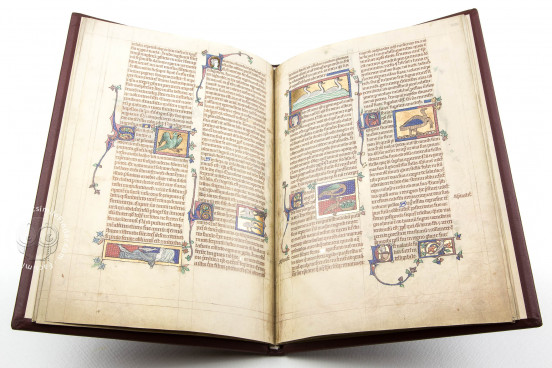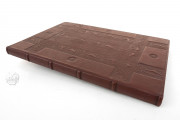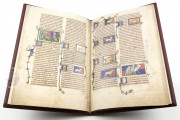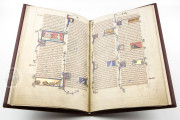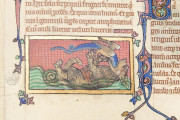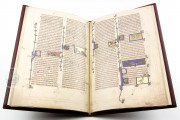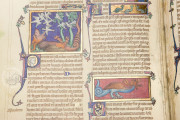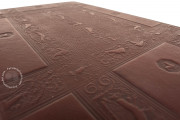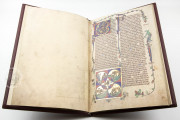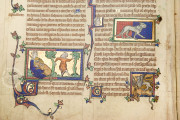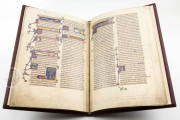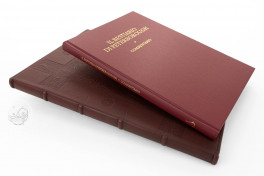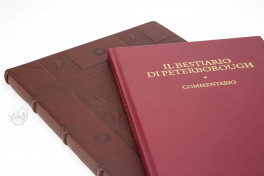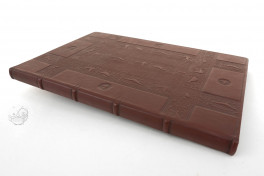Dating from the first decade of the fourteenth century, the Peterborough Bestiary is a charming example of English Gothic illumination. It is a collection of short texts describing animals, birds, fish, and mythological creatures, often offering a moralization. It boasts more than a hundred miniatures, each showing the animal described in the following text. The miniatures have colorful or gold frames, and the backgrounds are either gold or diapered (i.e., composed of repeated geometric patterns). There are also more than a hundred painted initials with leafy marginal extensions.
The principal sources for the animal descriptions are a Latin version of the Physiologus ("Naturalist"), a Greek text of the second century CE, and the Etymologiae ("Etymologies") of the Spanish bishop, Isidore of Seville (d. 636).
Extraordinary Illumination
Although many English bestiaries of the period were illuminated, the Peterborough Bestiary is among the most lavish and finely crafted. The miniatures, many the width of a column of the two-column text, are finely painted in brilliant color with ample use of gold leaf. The painted initials, filled with spiraling leaf motifs or occupied by human heads, are equally finely executed, and their sinuous extenders enliven virtually every page. The anonymous painter also worked on the De Lisle Hours (New York, Morgan Library & Museum, MS G.50).
Two Approaches
The miniatures that accompany Isidore's succinct texts are simple profile portraits of the animal. The miniatures introducing descriptions taken from the Physiologus are more elaborate, with allusions to habitat and behavior, and may include human figures. For example, the miniature for the camel shows two men lifting a sack onto the animal (fol. 196r).
King of Beasts
The book's largest miniature is the first, devoted to the lion. It is composed of five interlocking circular fields, each illustrating one of the described characteristics, including the beast's habit of eating an ape to cure itself of illness (fol. 189r).
A Book for Teaching or Preaching
The manuscript's pages are extraordinarily large for a bestiary; the script is Gothic Textura Quadrata, the most formal of Gothic scripts; and the whole is stately despite the sometimes amusing quality of the illumination. The contents are presented in an orderly fashion: beasts, mostly mammals (fols. 189r-198r); birds (fols. 198v-204v); serpents (fols. 204v-207v); and fish and aquatic animals (fols.207v-210r).
The scribe wrote the word spiritualiter ("spiritually," usually abbreviated) in the margin to draw attention to the morals drawn from the animal lore. This makes the book easy to consult in teaching or in preparation for preaching, and the manuscript was probably made for a cleric.
Bound with a Psalter
The bestiary came into the possession of Matthew Parker (1504-1575), Archbishop of Canterbury, perhaps from a monastic institution in the wake of the dissolution of the English monasteries in 1539. Parker probably had the bestiary bound with the psalter from Peterborough that gives the bestiary its nickname, although it is possible that the two parts were united earlier in their history. Parker bequeathed his substantial collection of manuscripts to Corpus Christi College Cambridge.
We have 2 facsimiles of the manuscript "Peterborough Bestiary":
- Bestiario di Peterborough facsimile edition published by Salerno Editrice, 2004
- Bestiarium aus Peterborough facsimile edition published by Faksimile Verlag, 2003

